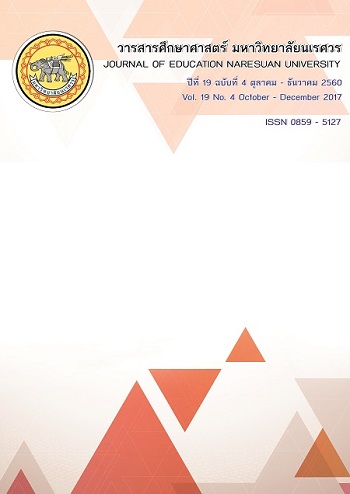DEVELOPMENT OF A FLIPPED LEARNING INSTRUCTIONAL DESIGN MODEL BASED ON TPACK FRAMEWORK AND ELABORATION THEORY FOR SECONDARY SCHOOL TEACHERS UNDER OFFICE OF THE PRIVATE EDUCATION COMMISSION
Main Article Content
Abstract
The purposes of this research and development were to develop, use, and validate a flipped learning instructional design model based on TPACK framework and elaboration theory for secondary school teachers under Office of the Private Education Commission (OPEC). Data were collected using a mixed-method research and divided into 4 phases as follows: 1) study opinions of experts and secondary school teachers; 2) create a model; 3) use a model by conducting an experiment study; and 4) validate the model. The research results indicated that: A Flipped Learning Instructional Design (FLID) model based on TPACK framework and elaboration theory for secondary school teachers consisted of eight components and twelve steps. The experimental group agreed that FLID model was appropriate and 315 students learned with the flipped learning were satisfied with high level. The FLID model validation results by experts was appropriate at an excellent level.
Article Details
The owner of the article does not copy or violate any of its copyright. If any copyright infringement occurs or prosecution, in any case, the Editorial Board is not involved in all the rights to the owner of the article to be performed.
References
Bergmann, J., & Sams, A. (2014). Flipped learning: Gateway to student engagement. Eugene, OR: ISTE/ASCD.
Creswell, J. W., & Clark, V. P. (2007). Designing and conducting: Mixed method research. Sage Publications.
Enfiled, J. (2013). Looking at the impact of the flipped classroom model of instruction on undergraduate multimedia students at CSUN. TechTrends, 57(6), 14-27.
Institute for the Promotion of Teaching Science and Technology. (2013). PISA 2015 results Mathematical literacy, reading literacy, and scientific literacy: executive summary. Bangkok: Advance Printing Service. (in Thai)
Jackson, R. G. (1993). The effect of elaboration theory in facilitating achievement of varied educational objectives in print/text materials (Doctoral dissertation). The Pennsylvania State University.
Kim, M. K., Kim, S. M., Khera, O., & Getman, J. (2014). The experience of three flipped classrooms in an urban university: an exploration of design principles. Internet and Higher Education, 22, 37–50.
Koraneekit, P., Songkram, N., & Khlaisang, J. (2014). Educational technology and communications: Blended learning innovation. Bangkok: Chulalongkorn University Press. (in Thai)
Li, K. H., Lou, S. J., Tseng, K. H., & Huang, H. C. (2013). A preliminary study on the Facebook-based learning platform integrated with blended learning model and flip learning for online and classroom learning. In: Wang, J. F., Lau, R. (eds) Advances in Web-Based Learning – ICWL 2013. ICWL 2013. Lecture Notes in Computer Science, vol 8167. Springer, Berlin, Heidelberg
Panich, W. (2013). Teacher for students: building a flipped classroom. Bangkok: RS Printing Mass product. (in Thai)
Phillips, C. R., & Trainor, J. E. (2014). Millennial student and the flipped classroom. ASBBS Proceedings, 21(1), 519-530.
Reigeluth, C. M., & Stein, F. S. (1983). The elaboration theory of instruction. In C. M. Reigeluth (Ed.) Instruction Design Theories and Models. Hillsdale, NJ: Lawrence Erlbaum Associates.
Reigeluth, C. M. (2012). Chapter 8: Instructional theory and technology for a postindustrial world. Trends and issues in instructional design and technology (3rd ed.). Boston, MA.: Dempsey, Pearson Education.
Richey, R. C., Klein, J. D., & Tracy, M. W. (2011). The instructional design knowledge base. New York: Taylor & Francis.
Staker, H. C., & Horn, M. B. (2012). Classifying K-12 blended learning. Retrieved March 5, 2014, from http://files.eric.ed.gov/fulltext/ED535180.pdf.
Udom, P. (2011). Active teaching and learning approaches in science (ATLAS). Journal of Education Prince of Songkla University, Pattani Campus, 22(3), 317-330. (in Thai)
Wiginton, B. L. (2013). Flipped instruction: An investigation into the effect of learning environment on student self-efficacy, learning styles, and academic achievement in an algebra I classroom (Doctoral dissertation). The University of Alabama.
Wongsuwankongpow, W. (2005). Development of an instructional model based on Reigeluth's elaboration theory for enhancing content accuracy, task expertise and transfer of learning abilities of higher education level students (Doctoral dissertation). Bangkok: Chulalongkorn University. (in Thai)
Yang H. H., & Chen P. (2010) Building teachers’ TPACK through WebQuest development and blended learning process. In: Tsang P., Cheung S.K.S., Lee V.S.K., Huang R. (eds) Hybrid Learning. ICHL 2010. Lecture Notes in Computer Science, vol 6248. Springer, Berlin, Heidelberg.


